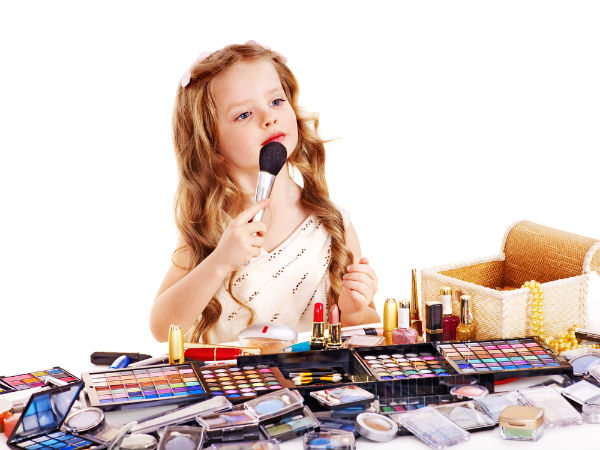Cosmetics & Kids – Advice from a Cosmetics Industry Expert
I often see little girls with their nails painted or playing with their mom's lipstick. Now my four year old daughter has been asking to paint her nails. My instinct was to say no, even if she uses “safer” nail polish. So I asked someone who used to work for a major cosmetics company about her real thoughts on cosmetics. These are her responses:
1. You have mentioned to me that nail polish is really terrible for you. What is so bad about traditional nail polish?
Nail polish is not terrible for you. The problem is when it chips off and is ingested (by children or by people who bite their nails). The fumes have been linked to miscarriage for women who work in nail salons but the products are probably safe for women (even pregnant women) who frequent the salon infrequently (1-2x per month).
2. Are the new “formaldehyde free” nail polishes better? Are they completely safe?
Formaldehyde has been linked to cancer and birth defects, so yes the formaldehyde free polishes are better than the old fashioned formulas. Toulane and DPB are the other offenders which is why you see “3-free” products on the market. Some brands are even marketing 5-free. My concerns with all of these products are the chemicals that have not been removed, or linked to reproductive problems (yet). There are binders and shine boosters that enhance performance, wear and color integrity.
3. Are the companies making these products aware that these chemicals could be harmful? What is their take on it?
The general consensus amongst industry experts is that children should NOT be ingesting these chemicals. That sounds obvious but when you see a 2 year old with painted nails, you realize parents don't understand this. Children who bite their nails (basically all kids under the age of 8) should not be getting manicures or pedicures with salon polishes.
4. What other makeup products would you be wary of and why?
For adults, makeup is fairly safe as long as it's free of Parabens. You absorb 60% of what you put on your skin. That makes lotions potentially the most toxic. But makeup, skincare, hair products and perfumes can all contain chemicals that are harmful. There needs to be more transparency on the part of manufacturers about what chemicals are in the formulations – specifically when you simply see the word “fragrance” in the ingredients list. Fragrance is a generic term for all kinds of chemicals that can potentially be harmful.
5. Are there certain brands you think are healthier than others?
Many brands that market themselves as “natural” actually are not. You really have to read labels and watch for the chemicals you're most concerned about.
6. Do you see a genuine shift in makeup brands being more careful about the chemicals they use?
Yes, cosmetics companies are under more and more scrutiny by cosmetics watchdog groups so they are being more cautious about what ingredients they use. I really believe the public can influence this by demanding more transparency and adherence to strict standards. Of course, they might have to give up product performance without the ingredients that contribute to color, longwear and finish, but you can't have it all.
7. What are some key things (ingredients, words on packaging, etc) that consumers should look for or avoid?
Some other chemicals to look for are listed here:
- BHA and BHT -Used mainly in moisturizers and makeup as preservatives. Suspected endocrine disruptors and may cause cancer (BHA).
- Coal tar dyes: p-phenylenediamine and colours listed as “CI” followed by a five digit number. Potential to cause cancer.
- DEA-related ingredients: Used in creamy and foaming products, such as moisturizers and shampoos. Can react to form nitrosamines, which may cause cancer.
- Dibutyl phthalate: Used as a plasticizer in some nail care products. Suspected endocrine disrupter and reproductive toxicant.
- Formaldehyde-releasing preservatives: Look for DMDM hydantoin, diazolidinyl urea, imidazolidinyl urea, methenamine and quarternium-15. Used in a variety of cosmetics. Slowly release small amounts of formaldehyde, which causes cancer.
- Parabens: Used in a variety of cosmetics as preservatives. Suspected endocrine disrupters and may interfere with male reproductive functions.
- Parfum (a.k.a. fragrance): Some fragrance ingredients can trigger allergies and asthma. Some linked to cancer and neurotoxicity.
- PEG compounds: Used in many cosmetic cream bases. Can be contaminated with 1,4-dioxane, which may cause cancer.
- Petrolatum: Used in some hair products for shine and as a moisture barrier in some lip balms, lip sticks and moisturizers. A petroleum product that can be contaminated with polycyclic aromatic hydrocarbons, which may cause cancer.
- Siloxanes: Look for ingredients ending in “-siloxane” or “-methicone.” Used in a variety of cosmetics to soften, smooth and moisten. Suspected endocrine disrupter and reproductive toxicant (cyclotetrasiloxane).
- Sodium laureth sulfate:Used in foaming cosmetics, such as shampoos, cleansers and bubble bath. Can be contaminated with 1,4-dioxane, which may cause cancer. Look also for related chemical sodium lauryl sulfate and other ingredients with the letters “eth” (e.g., sodium laureth sulfate).
- Triclosan: Used in antibacterial cosmetics, such as toothpastes, cleansers and antiperspirants. Suspected endocrine disrupter.
See source for ingredient list here: http://www.davidsuzuki.org/issues/health/science/toxics/dirty-dozen-cosmetic-chemicals/


